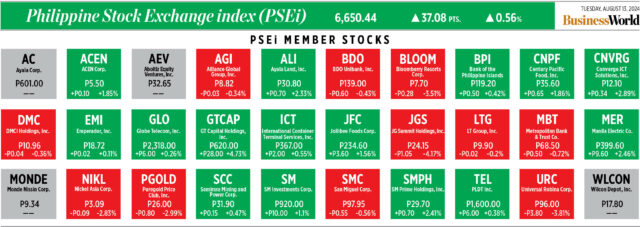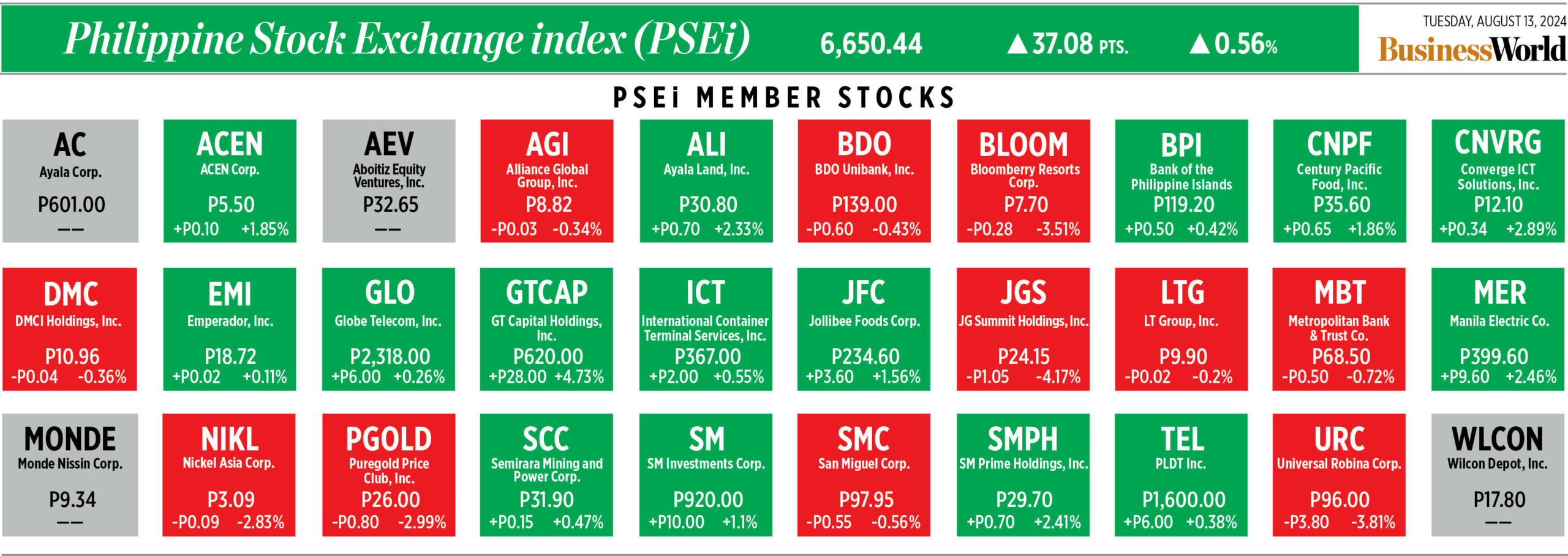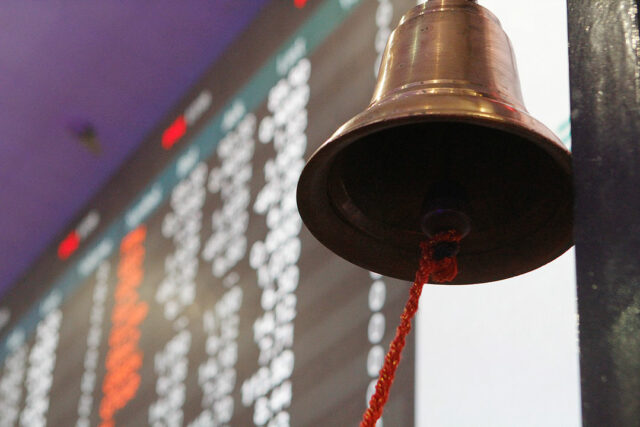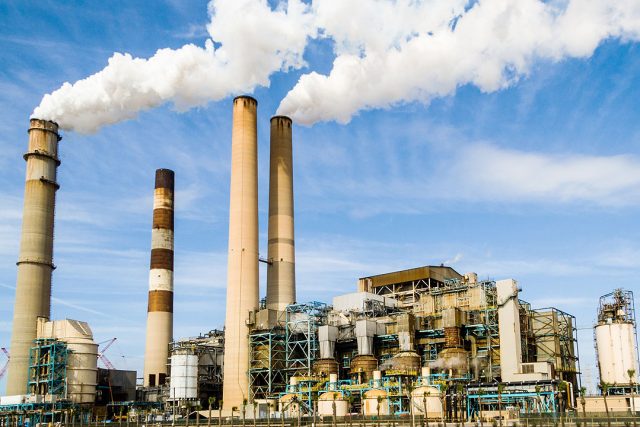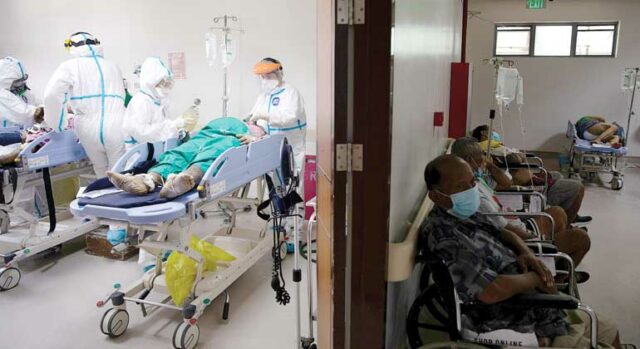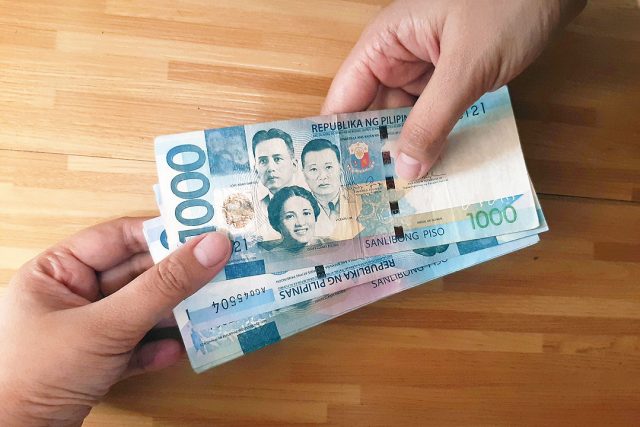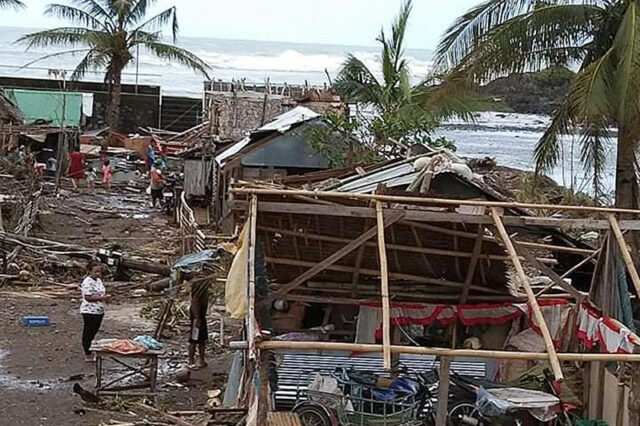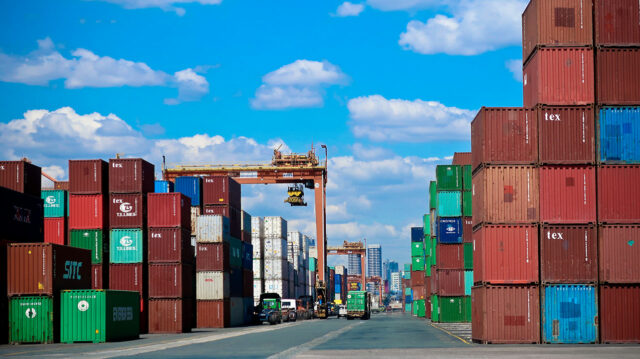PHL stocks rise on strong peso, corporate results
PHILIPPINE SHARES closed higher on Tuesday on positive sentiment after the peso returned to the P56 level against the dollar and strong corporate results.
The Philippine Stock Exchange index rose by 0.56% or 37.08 points to end at 6,650.44 on Tuesday, while the broader all shares index improved by 0.31% or 11.46 points to finish at 3,610.
“The local market bounced back this Tuesday. The peso’s strengthening against the dollar has helped in lifting the market. Investors’ appreciation of second-quarter and first-half corporate results also helped in bringing the market up,” Philstocks Financial, Inc. Senior Research Analyst Japhet Louis O. Tantiangco said in a Viber message.
On Tuesday, the peso closed at P56.96 per dollar, rising by 35.6 centavos from its P57.316 close on Monday, based on Bankers Association of the Philippines data.
This was the local unit’s best close in almost four months and was the first time it ended at the P56 level since its P56.808-a-dollar finish on April 15.
“Philippine shares rebounded, tracking their Asian peers, as investors continue to take positions ahead of the upcoming BSP (Bangko Sentral ng Pilipinas) meeting this Thursday,” Regina Capital Development Corp. Head of Sales Luis A. Limlingan said in a Viber message.
A BusinessWorld poll conducted last week showed that nine out of 16 analysts surveyed expect the Monetary Board to deliver a 25-basis-point (bp) rate cut at its meeting on Thursday (Aug. 15), bringing the target reverse repurchase rate to 6.25% from the current over 17-year high of 6.5%.
On the other hand, seven others expect the BSP to keep rates steady this week.
From May 2022 to October 2023, the BSP hiked borrowing costs by 450 bps.
“Meanwhile, Wall Street opened the week with choppy trading as investors awaited key inflation reports that could provide direction after last week’s volatility, driven by a weak jobs report and the unwinding of the yen carry trade,” Mr. Limlingan added.
Majority of sectoral indices closed higher on Tuesday. Property climbed by 1.69% or 44.13 points to 2,649.16; industrials went up by 0.56% or 50.70 points to 9,045.97; holding firms rose by 0.43% or 25.03 points to 5,743.04; and services inched up by 0.37% or 7.74 points to 2,086.95.
Meanwhile, mining and oil fell by 1.09% or 89.42 points to 8,102.52; and financials dropped by 0.18% or 3.66 points to 1,984.21.
“GT Capital Holdings, Inc. was the index’s top performer for the day, jumping 4.73% to P620. JG Summit Holdings, Inc. was the worst index performer, plunging 4.17% to P24.15,” Mr. Tantiangco said.
Value turnover climbed to P4.98 billion on Tuesday with 607.05 million shares changing hands from the P3.67 billion with 505.37 million issues traded on Monday.
Decliners beat advancers, 100 versus 81, while 64 issues were unchanged.
Net foreign buying dropped to P121.63 million on Tuesday from P205.66 million on Monday. — R.M.D. Ochave
‘Balanced’ energy mix keeps power affordable — biz groups
BUSINESS GROUPS said that the Department of Energy’s (DoE) pursuit of a balanced energy mix is suitable for achieving energy security while keeping power affordable.
In a joint statement on Tuesday, nine business groups led by the Management Association of the Philippines expressed support for Energy Secretary Raphael P.M. Lotilla’s policies, which they said were appropriate to the country’s particular context.
“As an emerging market, the country must balance energy security and affordability with climate change concerns to support its economic progress,” they said.
According to the groups, energy supply per capita is the third lowest in ASEAN, highlighting the need to prioritize the need to augment power capacity quickly amid growing energy demand.
“Even with the government’s goal of a 50% renewable energy share in the country’s power generation mix by 2040, it has left a sizable proportion for fossil fuel-based sources,” they said.
Criminal and administrative complaints have been filed against Mr. Lotilla by the Power for People Coalition (P4P) for endorsing the expansion of Aboitiz-controlled Therma Visayas, Inc. Unit 3 in Cebu.
In a statement last month, P4P said that the endorsement of the project violates the moratorium on greenfield coal-fired power projects declared by the previous administration.
Meanwhile, the business groups said: “The DoE has repeatedly made it clear that its own advisory on the moratorium on coal-fired power plants applies to greenfield projects.”
It added that the DoE is also working on the development of indigenous resources to reduce dependence on imported fossil fuels, to lower power costs, and to pursue energy efficiency to maximize energy resources.
“Energy insecurity is expensive. The power outage on Panay Island in January this year was estimated to have led to about P3.8 billion in economic losses for the Province of Iloilo alone,” the groups added.
The other signatories to the statement were the Makati Business Club, the Employers Confederation of the Philippines, the Federation of Philippine Industries, the Financial Executives Institute of the Philippines, and the Foundation for Economic Freedom.
Also signing were the Blockchain Council of the Philippines, Fintech Alliance.PH, and the Women’s Business Council Philippines.
On Aug. 5, the Philippine Chamber of Commerce and Industry (PCCI) also expressed support for Mr. Lotilla, noting that the allegations have the potential to push investors away.
“We are competing against other countries in the region in enticing foreign direct investment (FDI) to come to our shores; let us not create an air of uncertainty that could dissuade these investments,” the PCCI said in a statement on Monday. — Justine Irish D. Tabile
Largest solar project eligible for green lane treatment — BoI
THE Board of Investments (BoI) said on Tuesday that it awarded green lane certification to the P185-billion project of Terra Solar Philippines, Inc. (TSPI), which is expected to be the world’s largest solar farm.
In a statement, the BoI said that the certification covers TSPI’s 3,500-hectare Terra Solar project located across Nueva Ecija and Bulacan.
TSPI is a subsidiary of SP New Energy Corp. and MGen Renewable Energy, Inc., the renewable energy unit of Meralco PowerGen Co.
BoI Managing Head and Trade Undersecretary Ceferino S. Rodolfo said TSPI’s project will help in the Philippine transition to greener sources of power.
“The basic objective of the Philippines now under this administration is not just to grow — we are already the fastest-growing economy in the region — but more importantly, to transform the Philippine economy into a smart and sustainable hub for manufacturing and services,” he said.
The Solar PV (photovoltaic) and battery energy storage system project will be executed in two phases, with the first phase expected to supply 600 megawatts (MW) of output and the second phase adding 250 MW.
It was awarded an 850-MW Mid-Merit Power Supply Agreement from Manila Electric Co. (Meralco), under which it is required, upon completion, to supply 850MW of power.
MGen President and Chief Executive Officer Emmanuel V. Rubio expects the endorsement to fast-track projects that will accelerate the Philippines’ low-carbon transition.
“Having the green lane certificate is a testament to our commitment to excellence, innovation, and environmental stewardship,” Mr. Rubio said.
TSPI targets commercial launch for the first phase of the project by February 2026, with the second phase set to launch by February 2027.
Late last month, the company reported that the project is 56% complete.
The project last month was also certified by the Department of Energy as an Energy Project of National Significance, which is given to projects with capital investment exceeding $59 million.
Executive Order (EO) No. 18 established the “green lane” system in all government agencies to speed up the approval and registration process for priority or strategic investments.
The BoI said 102 projects involving investment worth P3 trillion have been endorsed by the BoI’s One-Stop Action Center for Strategic Investments.
Meralco’s controlling stakeholder, Beacon Electric Asset Holdings, Inc., is partly owned by PLDT Inc.
Hastings Holdings, Inc., a unit of PLDT Beneficial Trust Fund subsidiary MediaQuest Holdings, Inc., has an interest in BusinessWorld through the Philippine Star Group, which it controls. — Justine Irish D. Tabile
2023 healthcare spending rises to 5.9% of GDP from 5.6% a year earlier
HEALTHCARE SPENDING in relation to the size of the economy rose to 5.9% in 2023 from a revised 5.6% a year earlier, the Philippine Statistics Authority (PSA) reported on Tuesday.
Citing preliminary data, the PSA said the ratio of national health expenditure to gross domestic product (GDP) was the highest since the 6.4% posted in 2021.
Current health expenditure grew 9.2% to P1.24 trillion in 2023, while gross health capital formation expenditure more than doubled to P197.07 billion last year.
This brought total health spending to P1.44 trillion in 2023, up 17%. Spending was at its highest level since the PSA began to track health spending in 1991.
Out-of-pocket payments by households accounted for 44.4% of current health expenditure last year amounting to P550.19 billion, up 8.5%.
Government schemes and compulsory contributory healthcare financing rose 2.2% to P528.75 billion. These categories accounted for 42.6% of current health spending in 2023.
Spending by voluntary healthcare payment schemes rose 44.6% to P161.35 billion last year, accounting for 13% share of current health spending last year.
Robert Dan J. Roces, chief economist at Security Bank Corp., said the increase in health spending last year was due to inflation, an aging population, and rising cases of chronic disease.
“Higher healthcare costs may strain household budgets, impacting consumption and economic growth,” Mr. Roces said via Viber.
Inflation averaged 6% last year, accelerating from a revised 5.8% in 2022. It was the strongest reading since the 8.2% posted in 2008 at the height of the global financial crisis.
The economy grew by a revised 5.5% last year, slowing from 7.6% in 2022.
On a per capita basis, health-related spending rose 8.3% to P11,082.68 last year.
Hospitals received 46.1% of all health spending last year, against 48.9% in 2022.
In absolute terms, hospitals took in P571.77 billion, up from P554.98 billion a year earlier.
Retailers and other providers of medical goods took in 29% of spending (P360.05 billion in 2023 from P331.92 billion in 2022) while providers of healthcare system administration and financing accounted for 9% (P111.47 billion from P56.90 billion).
“In this case, it may be that healthcare costs are rising. But in the long run, in an inflationary environment, healthcare spending gets a smaller allocation in the budget of the consumer, favoring instead spending on other items such as food,” said Mr. Roces. — Charles Worren E. Laureta
Oct. delivery expected for 30,000 MT of imported fish
THE Department of Agriculture (DA) said that it plans to grant permits for imports of 30,000 metric tons (MT) of fish, for October delivery.
Agriculture Secretary Francisco P. Tiu Laurel, Jr. said that the DA is set to release the import order by next week.
“It will be set for arrival by October… this is lower than the 45,000 MT from last year,” Mr. Laurel told reporters.
The Philippines typically allows fish imports during the fourth quarter, coinciding with the closed fishing season imposed in some areas to restore fish populations.
Republic Act No. 8550 or the Fisheries Code, authorizes closed seasons in certain fisheries as a conservation measure, to allow commercially significant fish species to regenerate.
Asked which fish species are to be imported, Mr. Laurel said the order will cover shipments of round scad or galunggong, bonito, and mackerel.
He added that the DA had initially proposed imports of 35,000 MT of fish to the National Fisheries and Aquatic Resources Management Council (NFARMC).
“The NFARMC recommended 25,000 MT. So, I just decided to be on the safe side in the middle,” Mr. Laurel said.
In April, the DA issued Memorandum Order (MO) No. 17, which solicited applications to import 25,000 MT of frozen small pelagic fish for wet markets in the fourth quarter.
MO 17 allocated 80%, or 20,000 MT to commercial fishing companies, with the remaining 20%, or 5,000 MT, for award to fishing associations or cooperatives.
As of the second quarter, fisheries production fell 6.2% year on year to 1.02 million MT, according to the Philippine Statistics Authority. — Adrian H. Halili
Sugar harvest seen peaking late due to El Niño
THE Sugar Regulatory Administration (SRA) said the height of the sugar harvest as well as milling operations will be delayed due to the impact of El Niño on the cane crop.
“We are expecting an almost two-month delay in the peak of harvest season because the cane damaged by El Niño had to be re-planted,” SRA Administrator Pablo Luis S. Azcona told reporters late Monday.
“By November we could be at our peak. Last year El Niño hit during the harvest season, which was good because harvesting conditions were dry,” he added.
During the second quarter, cane production dropped 42.3% year on year to 1.63 million metric tons (MMT), according to the Philippine Statistics Authority, making sugar the crop most affected by El Niño during the three-month period.
He expected sugarcane production to be flat “or may drop tayo ng konti (output could fall slightly).”
“Right now, there are three mills confirmed to be opening by Sept. 15 in Negros, and they are not hopeful about the cane supply. Others will open by Oct. 1 or 15. In Bukidnon, mills are expected to open by Nov. 15,” he said.
“Batangas… might be delayed also. So, the season will be a bit delayed,” he added.
The government weather service, known as PAGASA (Philippine Atmospheric, Geophysical and Astronomical Services Administration), declared the start of El Niño weather event in June last year, bringing below-normal rainfall conditions, dry spells and droughts.
El Niño ended in early June 2024, PAGASA added, but dry conditions are expected to continue.
“We had five months or more of dry conditions in Negros, where the majority of the sugar comes from. Batangas was also hit so they’re expecting a drop. Mindanao, I’m not so sure of the data yet because they had the biggest increase last year,” Mr. Azcona said.
The regulator allowed imports of 240,000 MT of refined sugar to maintain a two-month reserve to keep prices stable. — Adrian H. Halili
NEDA warns of consequences if peso breaches P58 level
THE GOVERNMENT needs to ensure that the peso does not breach the P58-to-the-dollar level next year to ensure that the goal of becoming an upper-middle income country is not delayed, according to the National Economic and Development Authority (NEDA).
At a Senate finance committee hearing with the Development Budget Coordination Committee on next year’s P6.352-trillion national budget, NEDA Secretary Arsenio M. Balisacan said attaining upper-middle income status could slide to 2026 if the peso weakens past this threshold.
“For as long as we do not exceed P58 per dollar next year, among the other indicators, we expect to hit or to be reclassified as an upper-middle income country,” he told senators.
The World Bank defines an upper middle-income country as one having a gross national income (GNI) per capita of between $4,516 and $14,005.
The Philippines is classified as a lower middle-income country with a GNI per capita of $3,950. It has been at this income level since 1987, according to the World Bank.
Mr. Balisacan told reporters on the sidelines of the hearing that interest rates and inflation could affect the Philippines’ nominal income.
“It’s just one of the factors, because there’s interest rate differential and the inflation differential between us and our trading partners.”
Inflation accelerated to a nine-month high of 4.4% in July, which ended seventh straight months of inflation being confined to the central bank’s 2-4% target band.
“The full impact of foreign exchange rates depends on various other economic factors and policies, chief of which are offshore developments, which are beyond the control of both the central bank and the National Government,” Security Bank Corp. Chief Economist Robert Dan J. Roces, said via Viber.
Leonardo A. Lanzona, who teaches economics at the Ateneo de Manila, said the government should focus on expanding exports if it wants to improve its income status.
“We need to develop our domestic resources if we are to expand the economy,” he said via Messenger chat.
“Overvaluing the currency just to bring in the imports is not going to be efficient.”
The peso closed at P56.96 on Tuesday from P57.316 previously, its strongest finish since hitting P56.808 on April 15.
In May, the peso breached the P58 level for the first time since November 2022. The peso has been trading in the P57-P58 range since then.
Diwa C. Guinigundo, country analyst for the Philippines at GlobalSource Partners and a former central bank deputy governor, said:
“Per capita income is driven by good growth and employment dynamics, and stable inflation.” — John Victor D. Ordoñez
PHL rice import forecast cut to 4.6 MMT — USDA
THE US Department of Agriculture (USDA) said it lowered its Philippine rice import forecast by 2.13% to 4.6 million metric tons (MMT) this year due to weaker-than-expected purchases of Vietnamese rice.
In its latest Grain: World Markets and Trade report, the USDA said it downgraded its 4.7 MMT estimate issued in July.
Rice imports have totaled 2.49 MMT as of Aug. 1, according to the Bureau of Plant Industry.
It added that global production may likely be lower due to reduced output in Myanmar, Malaysia, Vietnam, and the Philippines.
The USDA is projecting milled rice production for the Philippines of 12.3 MMT.
At a budget hearing on Monday, Agriculture Secretary Francisco P. Tiu Laurel, Jr, said that the Department of Agriculture (DA) is projecting rice imports of 4 MMT in 2024.
For 2025, the USDA has a Philippine rice import estimate of 4.6 MMT.
In June, President Ferdinand R. Marcos, Jr. signed Executive Order (EO) No. 62 which lowered the tariff on imported rice to 15% from 35% until 2028. The new tariff regime is subject to review every four months.
The EO is expected to reduce the retail price of rice by P6 to P7 per kilogram, according to the DA.
The USDA said that global imports are expected to decline due to reduced purchases by the Philippines and Brazil.
It added that domestic production for 2025 will come in at about 12.7 MMT in milled rice equivalent. — Adrian H. Halili
Bamboo pellets touted as sustainable fuel
BAMBOO producers could tap the market for bamboo pellets amid growing demand for sustainable fuel, exporters said.
In an article, the Philippine Exporters Confederation, Inc. (Philexport) said noted the demand for bamboo pellets as a substitute for wood used in producing biomass fuel.
“There is significant export potential for bamboo pellets as an eco-friendly replacement for wood pellets used as biomass fuel, a trend the Philippines as a major bamboo producer can tap into, research has showed,” the group said over the weekend.
Citing Brown University’s School of Public Health, Philexport said that demand for clean energy alternatives has been surging, with the wood pellet industry projected to double in size by 2026.
Pellet fuels are made from compressed organic material such as sawdust and related industrial byproducts.
However, the wood pellet industry is facing scrutiny over its impact, including black carbon and volatile organic compounds produced in the processing trees into dried pellets.
According to Philexport, this makes bamboo pellets a potential substitute due to the plant’s rapid growth and minimal environmental impact.
“Bamboo pellets have a wide range of uses. They can be used in cooking, heating, and operating power plants to address insufficient power supply. They even make excellent animal bedding and animal feed,” it said.
“They are safe and convenient for transport and storage. The pellets are lightweight, and they can be stored for a very long time,” it added.
Citing the Philippine Council for Agriculture, Aquatic, and Natural Resources Research and Development, Philexport said that the Philippines is the sixth largest exporter of bamboo.
“While it has extensive use as a raw material in many industries, Philippine bamboo exports reportedly slowed from a high of 106,000 kilograms (kg) in 2011 to 35,000 kg in 2015 and even further to 8,000 kg in 2018. Exports just picked up to 66,000 kg in 2020,” it added.
The country exports bamboo products to the US, Japan, the UK, Germany, and France.
As of 2022, investments in the industry totaled P89 million, while domestic sales stood at P143 million. — Justine Irish D. Tabile
Calamity funds released by end of July top P13 billion
SOME P13.54 billion worth of calamity funds have been disbursed as of the end of July, the Department of Budget and Management (DBM) said.
According to the National Disaster Risk Reduction and Management Program report, calamity funds worth P13.04 billion were released to National Government agencies, while P499.94 billion went to government-owned and -controlled corporations (GOCCs) as of the end of July.
The Department of Public Works and Highways (DPWH) received P7.67 billion, followed by the Department of Social Welfare and Development (DSWD) with P4.64 billion.
Calamity funds worth P374.97 million went to the Department of Human Settlements and Urban Development, while the departments of Finance and National Defense received P255.5 million and P100 million, respectively.
Among GOCCs, the National Irrigation Authority was given P450 million, while the National Housing Authority (NHA) received P49.94 million.
According to the report, P875 million was released to the DSWD and P1 billion to the DPWH to replenish their respective Quick Response Funds (QRF), the DBM said.
The QRF is a stand-by fund for the aid, relief, reconstruction, and rehabilitation of calamity-affected areas.
A government entity may request replenishment of its QRF if the fund balance dips below 50%.
The DPWH also received P150.47 billion to rehabilitate typhoon damage in Pangasinan and Surigao del Norte.
The Bureau of the Treasury also disbursed P200 million and P26.24 million for typhoon and earthquake damage in Mountain Province, the DBM said.
Some P14.92 million went to support a crop and fishery recovery program in Batangas and P14.34 million to procure rescue equipment in Camiguin.
The DBM also approved the release of a P49.94-million subsidy to the NHA for a resettlement project following a 2022 earthquake.
Around P9.2 billion out of the P22.74 billion in calamity funds remains unreleased, DBM said. — Beatriz Marie D. Cruz
National Single Window to be implemented as PPP next year
THE proposed National Single Window System is expected to be implemented in May next year through a public-private partnership (PPP) with a Singapore company, the Department of Finance (DoF) said.
“There is a proponent for a PPP. It is a company from Singapore, together with Temasek (the Singapore government-controlled investment company), so they seem to be credible,” Finance Secretary Ralph G. Recto told a Senate hearing on the Development Budget Coordination Committee.
“Something like half a billion will likely be spent. And we’re pretty confident that by May of next year, we will have that National Single Window in place,” he told legislators.
Senator Cynthia A. Villar had queried the delayed implementation of the National Single Window system, which is designed to facilitate trade by streamlining Customs and other trade-related approvals into a one-stop shop arrangement.
The delays were blamed on an injunction that barred the Bureau of Customs from pursuing any change in its procedures.
“The Bureau of Customs, by virtue of mandatory injunction, is precluded from enhancing our system. We cannot enhance our customs processes at the moment because of that injunction,” Customs Commissioner Bienvenido Y. Rubio told the hearing.
Because of this, the DoF and the Department of Information and Communications Technology last year designated TradeNet as the National Single Window platform.
The BoC presides over the technical working group of TradeNet.
The TradeNet system also includes the automated and integrated licensing, permitting, clearance and certification system of 18 trade-related government agencies.
On the sidelines of the hearing, Mr. Rubio told reporters that there are communication challenges with some agencies that have yet to join TradeNet.
The Philippines is the only country in Asia that has not implemented a National Single Window System, Ms. Villar said. — Beatriz Marie D. Cruz

